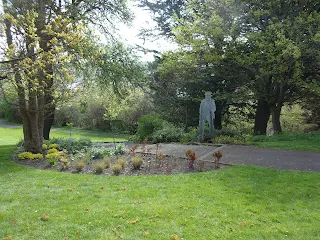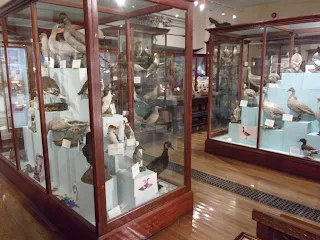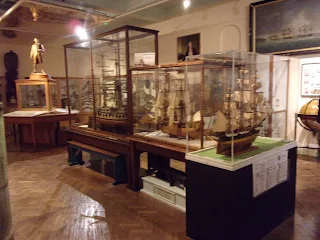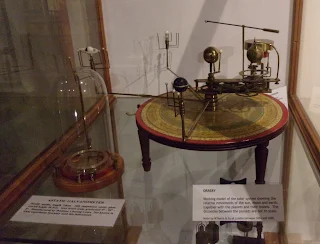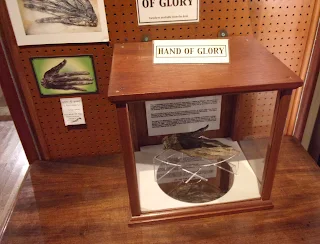Whitby Museum sits in Pannett Park, and shares a building with Pannett Art Gallery.
Pannett Park slopes downwards (or upwards, depending on which way you're facing!) and is very pretty and peaceful.
The flat metal sculpture depicts a gardener at work.
We entered via the art gallery and I was a bit naughty, as photography wasn't allowed in there. There are a myriad of paintings in this gallery; many by local artists and about local subjects. I love full moons in paintings, so I had to take a crafty photo of this.
Italian Scene, c.1900, by Joseph Alfred Terry (1872-1939)
These tapestries of Flora and Pomona were woven by Morris & Company, c.1900. The design is by Edward Burne-Jones.
Whitby Museum was founded in 1823 and is an independent museum, and entrance is very reasonably priced. A myriad of subjects are covered in here, and this cabinet is devoted to beautiful Whitby jet jewellery, which became fashionable during the Victorian age.
Whitby is famous for its jet, which is found locally. Jet is derived from wood which has turned mineraloid during extreme pressure. This jet chessboard dates back to 1899, and was made by John Sherwood in his local workshop.
Fossilised crocodile, found in 1824 near Whitby. At the time it was purchased by the museum for £7.
Ammonite shells, and ammonites were shelled cephalopods that died out about 66 million years ago.
Fossilised marine reptiles mounted on the wall...
More interesting friends clinging to the wall, and the museum has been in the present building since 1931.
Taxidermy, and there are sections of the museum dedicated to Local History, Photography, Maritime Heritage, Social History, Fine Art, Costume and Textiles, Jet and Jet Jewellery, Geology and Fossils, and Natural History. This section comes into the latter category...
It's been noted that nowadays we might find the idea of preserving and mounting insects and animals barbaric, but during the Victorian times, when modern photography was unavailable, collecting dead specimens or killing by means of hunting, fishing, gamekeeping and pest control was the only means of identifying and authenticating various species.
Birds' egg collection, including nests...
Colourful coral brought back to Whitby on ships...
Whitby history is forever linked to the sea, and this is The Shipping Wing.
Varied seafaring stories are told here, including the Whitby lifeboat disaster of 1861, when 12 men were lost. Only Henry Freeman- who was wearing a new design of cork lifejacket- survived, and his photograph is to the top left.
This room is dedicated to local lad Captain James Cook; one of the greatest explorers in history...
This maquette was the prototype for the Captain Cook Memorial Monument which sits on West Cliff, near the seafront.
James Cook circumnavigated the globe three times, taking in the Pacific Ocean, Australia and New Zealand and the American Northwest.
An orrery, and I've always found astronomy fascinating...
This room contains cabinets of delights brought back from (mainly) the Pacific regions...
The chap on his side looks quite scary- he is a rattle in the shape of a bird.
Back in the main room of the museum, and this odd contraption is called a Tempest Prognosticator. It dates from 1951 and consists of 12 glass bottles- which would have each contained a live leech- sitting underneath around a circular stand that would have contained 12 hammers. Believe it or not, this was supposed to predict storms at sea!
I loved this sparkly mother-of-pearl 1860 missal, which was in the Faith cabinet...
Metal household implements. This museum is certainly varied!
A cabinet full of eyeglasses...
At 12 metres (39 feet), this totem pole is the museum's tallest object, and arrived at the museum in 1932.
Model of Whitby Abbey as it once was...
Model of Whitby Abbey as a ruin...
These silver earrings were used as payment by Arab slave traders.
I'd wear them!
"Ayda-kati" National sword of Malabar (a region on India's southeastern coast.)
Of course, my eyes would hone in upon the slippers embroidered with gold thread...
Whitby photographers...
Toys feature, and I can remember reading Brer Rabbit when I was a kid...
Puppets...
Excavations, including ancient writing implements...
Relief map of Whitby Harbour...
This little baby is a Zeplin III dark matter detector. They are used to- you guessed it!- detect dark matter, a mysterious substance that makes up a significant portion of the earth's mass. They often locate them deep underground to minimise interference from radiation.
And now we come to the pièce de résistance- the Hand of Glory!
A Hand of Glory is supposedly a carefully prepared and pickled right hand of a convicted felon, cut off whilst the body was still hanging from the gallows. This particular severed, mummified hand was discovered in the wall of a thatched cottage in Castleton in the early 20th century. Previously, the cottage had been inhabited by a man who was not of pleasant character and suspected of crimes, but the police could pin nothing on him. The museum acquired it in 1935, and it is the only known Hand of Glory to survive. The hand is believed to be male.
It was used by burglars to send the sleepers inside a house into a coma, so that the house could be robbed. Two versions of this story exist- one dictates that the hand is used as a candleholder for a candle incorporating human fat. In the second, the outstretched fingers are lit, and if one of the fingers refuses to light it is a sign that someone in the house is still awake. The Whitby hand ties in with the latter version and, in both the light can only be extinguished with blood or blue (skimmed) milk. This hand could have been used as late as 1820.
We headed to the next level of the museum, which housed clothing exhibits.
I own a coat similar to the fur-collared one, only mine has a self-tie belt...
I loved this cabinet of historical elegance...
A closer view of a couple of period dresses...
I adored this decadent kimono-style attire...
Home crafts, and my mother owned a Singer sewing machine like this- I used to use it to make and alter clothes; as a rebellious teenage goth/ punk/ general weirdo!
Wash day and vintage underwear...
There is a temporary mini-exhibition showcasing Frank Meadow Sutcliffe's pioneering photography of Whitby, its surrounding area and its people.
Our Lasses- Inspirational Women of Whitby is another temporary exhibition, which speaks for itself. It showcases remarkable Whitby women throughout the ages.
The different roles women play, with notable names...
Women's suffrage...
Barbara Benson's ballet dress and pointe shoes. She was a Whitby dance teacher who founded a highly successful dance academy. She died only recently, in 2024, age 93.
I'll leave you with this wooden doll, named "Bess."
She has an unusual story. She belonged to the family of Thomas Hill (1855-1928), and Thomas would wait until his daughters dressed Bess up in baby clothes then throw her into the harbour, training his dog to rescue her. Whether the dog's services were needed or not, we don't know!
Incidentally, I had a dolly named Bessie as a child. She went for a swim when a wave came in too far, up the coast at Filey whilst we were paddling. My dad quickly rescued her and I wrote a poem about it a couple of years back. The poem only took me about five minutes to write, but I entered it into a competition and it became a runner-up.
This wooden sculpture sits inside a small park adjacent to Pannett Park...
The park is unnamed, but is known locally simply as "Little Park."
The view from the park is pretty decent, and I love the way the tree branches form an ivy arch.
I took photographs of a few oddments that interested me around the town. The sculptures below are by Emma Stothard, there are nine in total and this one's called Bridgender.
Fishwife.
Netmender.
I loved this olde-worlde type wooden sculpted sign, which says The Pantry Door.
I adored the sheer decadence of this bar signage- it has something about late 19th century Paris about it.
"Better Late Than Ugly" had me in paroxysms of laughter!
The Abbey Steps Tearoom is the epitome of cute. It sits at the base of the 199 steps and adjacent Donkey Road.
I popped into The Ebor Jetworks, and watched their jeweller polishing and fashioning pieces of jet.
This alleyway labelled Old Smuggler comes complete with instructions of duck or grouse!
I believe I had a small argument with the SuperDean looking for Arguments Yard!
Dark Entry Yard. That sounds like something that goes on in a gay bar. Ooh err, missus!😁
The huge polar bear symbolises the cub who was brought back to Whitby from Greenland during the height of whaling (whale oil was used for street lighting, and the bones for women's corsets). Although tamed by whaling captain William Scoresby Senior (1760-1829), the bear became spooked one day and was eventually sent to the Tower Zoo in the Tower of London.
Well, I never! A traditional red phone box- you don't see many of these nowadays.
The River Esk at dusk.💜
The same view at nighttime.💜
I've also blogged about Whitby Abbey, which gives you additional Whitby info, link:-
Whitby, I will return.
Until then,
TTFN
Miss Elaineous
XXXXXXXXXXXXXXXXXXXXXXXX
XXXXXXX
X
XXXXXXX
X


